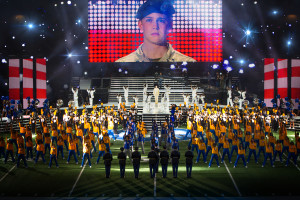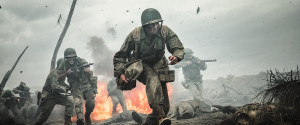And when all the people who had gathered for the spectacle saw what had taken place, they returned home beating their breasts. (Lk. 23:48)
Two movies about war are currently in the theatres. One directed by Ang Lee, the other by Mel Gibson.
At the heart of both movies is an intense and powerful spectacle around which the rest of the story revolves and which rivets attention. Of course all movies are spectacle, and war is so often the subject of movies because it provides such concentrated material for spectacle: what can be more gripping to an observer than the sight of many people dying? Examples multiply in the memory: All Quiet on Western Front, Lawrence of Arabia Apocalypse Now, Platoon, Cross of Iron, Full Metal Jacket, Saving Private Ryan, Fury. The list goes on and on
But there is something much more deliberate and reflective in both these recent offerings.
The first, Billy Lynn’s Long Halftime Walk, pivots on a halftime show at a Thanksgiving Football Game in Dallas, Texas.

The other, Hacksaw Ridge, climaxes in a set-piece WW2 battle on Okinawa Island, happening at the top of the eponymous ridge which looms up on screen like a terrifying stage seen from the orchestra pit, a huge escarpment which the soldiers must finally climb to make their appearance and be blown to bits.
 A sense of spectacle as spectacle undergirds both movies, a conscious meta-awareness of what exactly it is we are waiting for and watching when we watch.
A sense of spectacle as spectacle undergirds both movies, a conscious meta-awareness of what exactly it is we are waiting for and watching when we watch.
A philosophical group called “Situationists” argued that society itself has devolved into spectacle. And they said this before the internet age. One of their leading figures, Guy Debord, explained “The spectacle is not a collection of images rather, it is a social relationship between people that is mediated by images,” He saw the enormous upsurge of electronic images as a manipulation of life by consumer culture, not real relationships. There is truth in this (especially from a mimetic perspective), but what he perhaps missed was the fact that society has always been based around the spectacle of sacrifice. The original or ur-spectacle is the killing of the collective victim. What is different today is that almost everything is spectacle. But at the same time–as these two movies illustrate–spectacle is coming consciously to recognize the violence and victim at its heart. It does so by means of the lightning strike of a radical human alternative– compassion.
The story of Billy Lynn’s Long Halftime Walk, focuses on a squad of soldiers who were involved in a vicious firefight caught on camera in Iraq. The news footage made them heroes, and they return stateside on a promotional tour, fawned on and feted, driven round in a stretch Hummer by a movie agent who never stops talking up a deal on the phone. Everything leads to their centrepiece appearance at the halftime show, directly following a song from the early Beyoncé (Destiny’s Child), “Soldier.” There is a seamless continuity between the war and the entertainment industry, while the men who were actually in the battle seem almost psychotically detached from what is going on around them. There is a constant sense of danger in this detachment, until at one crucial moment the key soldier who provides the main narrative thread breaks and begins to weep. A tear on the face of this once-innocent soldier breaks the manic continuity and rips it apart.  I have called moments like this in other movies “the photon of compassion,” the point where the dizzying vortex of violent images suddenly opens to the new transcendence of compassion arising historically from the Risen Crucified.
I have called moments like this in other movies “the photon of compassion,” the point where the dizzying vortex of violent images suddenly opens to the new transcendence of compassion arising historically from the Risen Crucified.
Spectacle itself is in crisis. It is no longer able to bring sacrificial resolution; so it is always amping up the images, the violence, the desire. But then, out of the intolerable danger, compassion appears.
Next, Gibson.
No one does violence like Gibson does. There is a transparency, a visibility of violence that is in many ways unique to Gibson. It is not pleasant. It is not moral. It is structural.
Watching a movie by Gibson is as if the human tissue itself is stretched out as screen and image. It is as if the Girardian foundation of culture in the body of the victim has become violently visible in the function of the movie camera itself: the body of the victim is rendered in and as the apparatus of spectacle. Directors like Sam Peckinpah (The Wild Bunch, Straw Dogs) and Tarantino (Pulp Fiction and Django Unchained) are known to create an aesthetic out of violence. The vivid glaze on the surface of the screen is made out of blood and cruelty. Even with these directors there is something revelatory. But it is too slick, too knowing and collusive. With Gibson there is a deep structural unease, a deliberate lack of comfort. As the body count rises and the flesh wounds multiply we find it more and more difficult to collude. The glaze is too layered, too thick! We HAVE to notice it. This has been interpreted as bravado, as a sheer liking for violence. This is even possibly true. But his three last movies, Passion of the Christ, Apocalypto, and now Hacksaw Ridge, all have an explicitly biblical-revelatory frame, which makes it impossible to avoid spiritual responsibility for what we are watching. The Passion of the Christ is seen among liberal Christians as reflecting an appalling atonement theology: violence before God saves us from our sins. This, I think, is a mental alibi showing zero sense of the art and meaning of cinema. The biblical framework in these Gibson movies is an explicit affirmation of a revelatory process that is working itself out in the cinematic representation of violence.
Girard actually made this point about Gibson’s movie, comparing its graphic realism to the work of Renaissance artists like Hieronymous Bosch, Matthias Grunewald, and Caravaggio. (He doesn’t mention the 20th century Irish artist, Francis Bacon, but Bacon’s visceral crucifixions would surely provide a bridge between Renaissance art and Gibson’s bloody cinema: Bacon said, “it was just an act of man’s behaviour to another.” )
Gibson’s Hacksaw Ridge lacks the teardrop of compassion. (The end of The Passion had a giant one falling from the sky: was it God, the universe or cinema itself which wept?) What Hacksaw does have is the prolonged, death-defying action of the central character, a medic who refuses to carry a gun but carries a bible and bears 75 wounded men to safety during the course of the battle. The movie is based on the true story of Desmond Doss, Seventh Day Adventist who joined the army but refused to carry a weapon. At the end of the movie Doss, himself seriously wounded, is lowered on a stretcher from the ridge. The camera pans below the body as it is stretched out in the sky above. It is a moment of gospel transcendence, the photon of compassion.
“And then the sign of the Son of Man will appear in the sky and all the tribes of the earth will mourn.”
These two movies are scintilla of that sign, glimmering in the semiotic sky of the movies.